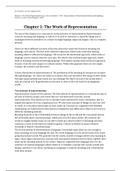For references see the original article
Chapter 1: The Work of Representation (pp. 1-20), from Hall, S. (1997). Representation: Cultural Representations and Signifying
Practices. London, United Kingdom: SAGE.
Chapter 1: The Work of Representation
The aim of this chapter is to concentrate on the practices of representation. Representation
connects meaning and language to culture. It is used to represent or stand for things and is
exchanged between members of a culture through language, signs and images. This is a complex
process.
There are three different accounts of theories about the connection between meaning and
language; and culture. The first is the reflective approach, which looks at already existing
meaning which is reflected by language. The second is the intentional approach, which looks at
language used to express what the user says. The third is the constructionist approach, which
looks at meaning constructed through language. This chapter mostly looks at this last approach,
because it has the most impact on cultural studies. Within this approach there are two major
variants, the semiotic and discursive.
A short description of representation is “the production of the meaning of concepts in our mind
through language”. So, when one looks at an object, they can reproduce that image in their mind.
Through visual material and words one can exchange the object, but never the actual object,
only the concept of it. Reproduction can be used to refer to the real world or an imaginary
world.
Two systems of representation
Representation consist of two systems. The first system of representation is a conceptual map of
all sorts of objects, people, and events that are correlated with concepts, mental
representations. This system we use to interpret and represent the world. Disclaimer, this is a
simple description of a very complex process. We also form concepts of things we can’t see, feel
or touch, or even places and people we have made up. Concepts are organized and classified,
relationships are built between then based on similarities and differences. Objects can be put in
different classifying systems.
Meaning depends on the relationships between things in the world and the conceptual system.
We all broadly share conceptual maps, which puts us in the same culture. We interpret the
world in roughly similar ways, we are able to build up a shared culture of meanings and thus
construct a social world which we inhabit together. Culture is defined in terms of shared
meanings or shared conceptual maps.
The second system of representation is language. Conceptual maps alone are not enough to
share meaning, we need language for that. The word language is in the broad sense of the word,
going beyond just words. The general term for words, sounds or images which carry meaning is
signs. These signs represent the concepts and conceptual relations between them, together they
make up the meaning system of our culture. Signs are organized into languages and it is the
existence of common languages which enable us to translate concepts into words, sounds and
images, and then to use these, operating as a language, to express meanings and communicate
with other people.





